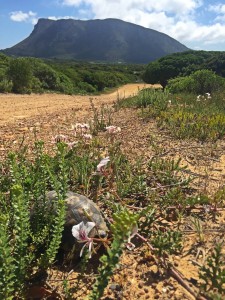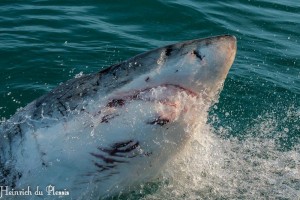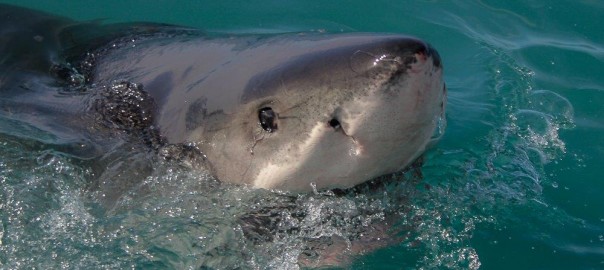
Gansbaai Tourism has launched a sunset walk, which will be conducted from the Tourism office to the Gansbaai fresh water fountain, in aid of the Gansbaai Academia Marimba Band.

Gansbaai Tourism has launched a sunset walk, which will be conducted from the Tourism office to the Gansbaai fresh water fountain, in aid of the Gansbaai Academia Marimba Band.

Shark Diving Unlimited has been nominated the best adventure activity for the second year running in the Lilizela Tourism Awards.
The Awards which recognise fair and responsible tourism companies, nominated the company for the second year in a row.
Shark Diving Unlimited takes great care in providing enjoyable shark cage diving trips for all people regardless of their ability, age, or monetary situation.
Based in the Great White Shark capital of the world, Gansbaai South Africa, the company also tries to give back to the ocean, by supporting a number of scientific field research studies on the Great White Shark.
To vote please visit: http://lilizela.co.za/voting/selected/VisitorExperience/356
Brave, fearless, free woman of the sea, capable of jumping into shark infested water and braving the chill of the winter waters.
That lasted about 10 minutes, the length it took for the boat to leave Kleinbaai harbour and arrive at our shark cage diving location, 10 minutes out to sea in a place called Shark Alley.
I joined Shark Diving Unlimited for the cage diving adventure of a lifetime and has spent the past 3 weeks telling everyone how I thought this activity would be a piece of cake. But then I was singled out, in my wetsuit, to be the first in the cage. I lifted my leg over the side of the boat and watched the large 3 metre white shark below me.
“Just find your feet and keep them inside the cage,” said the burley black chum man as he near hoisted me over the edge and into the cold cold water.
The adrenalin hit then. Although I knew I was in a big metal cage, it does make you feel insignificant when placed in the middle of the ocean with its apex predator.
“Down!” they yelled.
And scrambling to hold my breath, dip down and keep all limbs intact, I did so.
She cruised by as calm and steady as an Emirates A380. Looked me in the eye, lost interest and continued past.
For her, it was an insigficiant moment in her day.
For me? Utter excitement, fear and happiness all rolled into one.
I will return, fair beauty of the sea!

We’ve had some great shark cage diving action this week, with 3 medium sized animals spending time in Shark Ally near Gansbaai. Our guests got some really nice images of Great White Sharks, coming nice and close to the boat.
We were happy to meet a few interesting people this week. A mom and daughter out on an adventure holiday from Pretoria and 30 elite athletes, in South Africa for training in Cape Town, also took time to come and take a dive, with their high protein packed lunches in hand.
With the long weekend, we also had a lot of families onboard. We had a 7 year old girl enjoying the action, begging to be first in the cage. Such a little daredevil.
We looking forward to the coming winter when breaching trips will begin again. But for now we will enjoy the perfect sunshine!
Shark Diving Unlimited is very pleased that the latest scientific paper we sponsored for Dr Sara Andreotti of Stellenbosch University, has been published.
The lack of a standardized procedure for collecting data about elusive and hard to find species like the great white shark has to date seriously hampered efforts to manage and protect these animals.
But now a marine biologist, an applied mathematician and a software developer from Stellenbosch University joined expertise to develop a custom-made software package, called Identifin, which may offer a solution to this problem.
Dr Sara Andreotti, a marine biologist in the Department of Botany and Zoology at SU, have collected over 5000 photographic images of the dorsal fins of white sharks along the South African coastline as part of her research. This is because the trailing edge of the dorsal fin provides a unique trade, analogous to a human fingerprint.
Over six years she managed to manually build a database with information on when and where an individual white shark was sighted. In those cases where she was able to collect a biopsy from the shark, the genetic information was linked to its profile.
But she was doing all this manually on her personal computer.
“I nearly lost my head. I quickly realised that in the long term updating the database was going to consume more and more of my time. That is when I headed over campus to the applied mathematics division and asked for help. I was stunned when they became all excited about my data,” she laughs.
Prof. Ben Herbst, a specialist in machine learning, and Dr Pieter Holtzhausen, a software engineer then busy with his PhD in Applied Mathematics, were literally overjoyed to be able to work with Dr Andreotti’ s data base.
Dr Holtzhausen explains: “We used an algorithmic technique called dynamic time-warping to match the fingerprints. With this technique, any data that can be turned into a linear sequence can be analysed. The technique is often used in speech recognition software.”
The image recognition software they developed, called Identifin, compares a semi-automatically drawn trace of the back edge of the dorsal fin to existing images in the database. The images in the database are then re-arranged and ranked by probability of match. If there is a match, the database photograph in the first position will be the correct one.
This is what the interface of the Identifin - fin matching - program looks like. A researcher takes the original photograph (a) and indicates the top and the bottom of the fin. The software then automatically traces the notches pattern (in red). Image: courtesy Dr Sara Andreotti.
The researcher then asks the software to match the traced photograph with existing images from the sharks’ database. Image: Sara Andreotti
However, while working with Michael Meyer, a marine scientist from the Department of Environmental Affairs, and shark conservationist Michael Rutzen from Shark Diving Unlimited, Dr Andreotti realised that the software needed some more tweaking if it were to fit the ideal of sustaining a large database for the long-term monitoring of the white shark population.
“The software had to be capable of quickly matching the fin identification of a newly photographed shark with a possible existing match in the database, and to automatically update the sharks’ id catalogue. The database also had to be user-friendly and structured in such a way so that different researchers can use it over the long term,” she explains.
The custom-made software uses the complete database for comparing the matches and then organises them in order of similarity, from left to right. There is also an embedded function in the software to create a matrix of the history of recaptures. This information can be used to estimate population numbers. Image: Sara Andreotti
While there is still room for improvement, the success of the first trials boosted their hope that in the near future they will be able to use Identifin to monitor white shark populations on a large scale.
“Previously, while at sea, I had to try and memorize which shark is which, to prevent sampling the same individual more than once. Now Identifin can take over. I will only need to download the new photographic identifications from my camera onto a small field laptop and run the software to see if the sharks currently around the boat have been sampled or not.
“By knowing which sharks had not been sampled before we can focus the biopsy collections on them. This saves us both time and money when it comes to genetic analysis in the laboratory,” she adds.
Dr Andreotti says to date the lack of standardization of data collection has been a major limitation to combining datasets of worldwide distributed species: “We hope Identifin will offer a solution for the development of a South African and then global adaptive management plan for great white sharks.”
The next step is to adapt Identifin for the identification of other large marine species and help other researchers facing the same kind of struggles.
Contact details
Dr Sara Andreotti
E-mail: andreottisara@gmail.com
Mobile: 072 3219198
Dr Pieter Holtzhausen
E-mail: holtzhau@gmail.com
Mobile: 084 998 6386
Additional reading
Andreotti S, Rutzen M, Wesche PS, O’Connell CP, Meÿer M, Oosthuizen WH, Matthee CA (2014) A novel categorisation system to organize a large photo identification database for white sharks Carcharodon carcharias. African Journal of Marine Science 36:59–67. Available online at
http://www.tandfonline.com/doi/abs/10.2989/1814232X.2014.892027?journalCode=tams20
Andreotti S, Heyden S von der, Henriques R, Rutzen M, Meÿer M, Oosthuizen H, Matthee CA (2016) New insights into the evolutionary history of white sharks,Carcharodon carcharias. Journal of Biogeography 43:328–339. Available online at http://onlinelibrary.wiley.com/doi/10.1111/jbi.12641/abstract
Andreotti S, Rutzen M, Walt S van der, Heyden S Von der, Henriques R, Meÿer M, Oosthuizen H, Matthee C (2016) An integrated mark-recapture and genetic approach to estimate the population size of white sharks in South Africa. Marine Ecology Progress Series 552:241–253. Available online at http://www.int-res.com/abstracts/meps/v552/p241-253/
Issued by Wiida Fourie-Basson, Media: Faculty of Science, Stellenbosch University, 021 808-2684, science@sun.ac.za

Got a hardcore mountain biker in the family?
Gansbaai’s newly launched mountain biking routes are now abuzz with mountain bikers and are the perfect distraction for biking family members while the rest of the family is shark diving.
The routes make a great training ground for this years mountain biking races, such as the ‘Cape Epic’ which kicks off in March.
The two black trails are proving the most popular with these expert riders, who value the challenge the variety of terrain; steep rocky descents, tight switchbacks and spectacular views, in our beautiful Fynbos Reserves.
There are two new black routes, but the one starting at De Uijlenes is the most challenging. Fit riders with good technical ability love this trail for its fun single track sections, stream crossings, rock berms, tough climbs, and exhilarating, fast technical descents through Flower Valley and above Stanford and Pearly Beach.
Klipspringer Trail, the other black option, starts at either Lomond Wines or Flower Valley Conservation and is approximately 32km long. It crosses five different properties in the Walker Bay Fynbos Conservancy and the views and surrounding natural environment are breathtaking.
Riders looking for some ocean views will love the Blue route which starts at Gansbaai Information. This 25km long route follows a 4 x 4 track by the sea, the sandy slopes and the beautiful Danger Point Lighthouse.
The red route also starts at Gansbaai Information and is 85km long. This route is more rural with steeper climbs. It follows the peaceful Baardskeerdersbos road over Sopieshoogte, past the Kraaibosch dam to Papiesvlei and over Nuwepos to Baardskeerdersbos and back to Sopieshoogte. The total elevation is roughly 1200m, with the 40m Nuwepos climb the longest ascent.
Guests to Gansbaai and surrounding areas can view the The ‘Lighthouse to Lighthouse’ race near the Danger Point Lighthouse in Gansbaai on 11 February or join it to train for the Cape Epic. The ‘Cape Epic’ passes through Hermanus from 16th March.
For more information visit www.gansbaaiinfo.com


We love Great White Sharks, but they aren’t really very cuddly are they? Fortunately, Gansbaai has a lot of other friendly animal residents, you can meet on your visit.
As soon we enter the town, we are asked to keep an eye out for moving rocks on the road! These rocks, or tortoises as they are usually known, flourish all over this green region because of the healthy Fynbos forests. Walkers are most likely to come across one in the morning at around 10am, as they set off in search of juicy flowers to munch. We do recommend that you don’t pick up these cute critters however, as they have a habit of doing a nice smelly pee on those who want a closer look.
Some of the cutest inhabitants include the The Cape Fur Seal who can usually be found on Seal rock near Dyer Island, where they breed. Viewing is best done from a cage diving boat as their island is located on Shark Alley, home to one of the largest concentrations of Great Whites in the world!
Dyer Island is also home to happy little penguins. The penguins are know as Jack Ass penguins because of their funny call. They are very endangered here, but you may be able to spot one or two during your cage diving trip. If not, you can always stop off at Betty’s Bay on your way back to Cape Town, where there is a large colony that often comes to shore.
The biggest animals residents of Gansbaai are the whales, and Southern Right Whales are often seen frolicking with their calves just offshore. These majestic animals give birth in the waters near De Kelders and can all be viewed from land or the guest houses there.
Gansbaai’s most elusive inhabitant is the Cape Leopard. Once well distributed across the Cape, their numbers are now dwindling from habitat destruction. You might catch sight of one if you are staying on one of the rural properties, or see one crossing the road at night.
So if you like animals, we recommend you come and spend a weekend in Gansbaai and get to know the furry, slow, loud, stealthy and majestic residents of Gansbaai!

Gansbaai is not only filled with sun hungry tourists, looking for shark action. Many others have arrived to take advantage of the towns flat streets, beautiful beaches and mouthwatering restaurants.
The best place to start is to hop on a bike and take a ride from Kleinbaai Harbour along the sea to Franskraal shops. Here you will find a welcome soft serve ice-cream (with choc stick!) to contemplate the trip back along this flat and quiet cycle route.
Diners will love the choice of seaside restaurants, offering fresh seafood and local South African fare.
For shoppers, there is the antique store in town opposite ABSA. This place is a treasure trove of homewares, furniture and decorative items.
Hikers will love to walk the De Kelders cliff tops at sunset, looking out for the regular whales that call this cove home for much of the year.
4 x 4 enthusiasts will love to explore the Plaat. It’s rocky trails and breathtaking views over Walker Bay, are the perfect choice for a stormy or overcast day.
If heading out shark cage diving, Shark Diving Unlimited offers diving for all ages, and also offers boat viewing and photography trips for those who don’t want to get wet! Think outside the box when you are in Gansbaai, there’s something for the whole family! www.sharkdivingunlimited.com

There’s no greater sight than a 1 tonne Great White Shark launching itself out of the water, right by your boat, in hungry pursuit of a seal. Shark Diving Unlimited in Gansbaai, South Africa runs breaching trips from May to August each year so that you can witness this spectaculr behaviour.
Breaching is thought to be part of the Great White Shark’s hunting behaviour and only occurs in the South African winter months. It is thought that they only exhibit this activity in one place in the world, Gansbaai, two hours South of Cape Town. During winter visibility is excellent in this region and tours are especially popular with photographers and those who want to enjoy the majesty of these animals but don’t want to get their feet wet.
Breaching trips head out at first light and last approximately 2-3 hours. An artificial seal is towed behind the boat to entice this apex predator to breach and guests then brace themselves for this rare spectacle with cameras at the ready. During their visit guests are treated to breakfast, snacks on board and a light lunch after the trip.
Mike Rutzen, well known shark behaviourist, conservationist and owner of Shark Diving Unlimited, was the first person in the world to witness this behaviour from both above and below the water in his documentary Great White Shark: A Living Legend.
“The first time I saw this behaviour my heart skipped a beat, it is truly magnificent and right up there with observing lions hunting or fighting. The great white shark is worth a lot when slaughtered for its jaws and teeth, but alive it is truly the greatest sight”
Great White Sharks are listed as Vulnerable by the IUCN Red List and are primarily being threatened by baited hooks, which are used by the government to protect swimming beaches, by hooking (and in most cases killing) sharks. Poaching for the shark’s valuable jaws and teeth is also a huge problem in the preservation of this species.
Shark Diving Unlimited uses most of its profits to fund scientific research, in collaboration with Dr. Sara Andreotti, a marine biologist at Stellenbosch University. Together, they have been attempting to preserve the great white shark through a series of studies on their behaviour and genetics.
Shark Breaching trips are 10 000 ZAR per boat ride for 1-8 people and the cost is split between all the guests on any given trip. It is also possible to book an exclusive breaching trip for 10 000 ZAR. In addition, those wishing to go shark cage diving can do so all year round at a cost of 1500 ZAR. Return transfers from Cape Town are 450 ZAR per person return.
To book please email us at info@sharkdivingunlimited.com or call us all hours: +27 (0) 82 441 4555